Authentic Cornish Pasty Recipe
This post may contain affiliate links. See my disclosure policy.
The national dish of Cornwall, England, this authentic Cornish Pasty recipe features savory flaky pastry pockets filled with beef and vegetables. Cornish pasties have a long and fascinating history and are the very essence of comfort food. Learn how to make a Cornish pasty the authentic and traditional way.
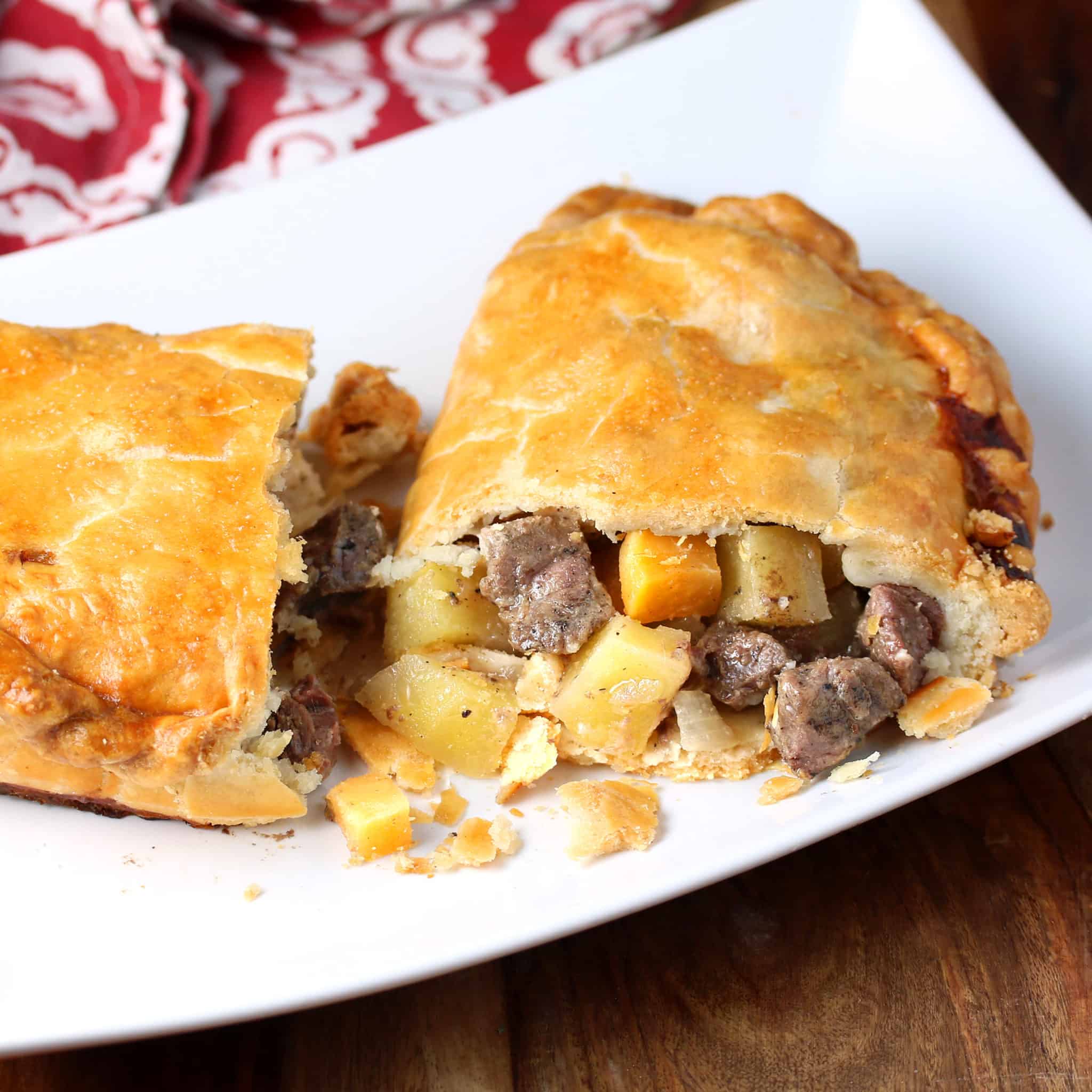
I love Great Britain. I lived in Cambridgeshire, England for nearly 7 years and my husband spent 2 years in Liverpool and north Wales. We’re both Anglophiles through and through and go back at least once a year for a visit with our kids. We love every area of Great Britain and it’s hard to pinpoint a favorite area. But Cornwall holds a very special place in our hearts and no matter where else in England we’re visiting, we always make time for a visit to Cornwall.
A Brief Cornish Family History
We love Cornwall not only because of its striking natural beauty, rustic charm and rich culture, but also because it’s home to my husband’s namesake ancestors, the Killigrew family (later changed to Killebrew when his great+ grandfather immigrated to the U.S.). The Killigrews were landed gentry and one of the most prominent families in Cornwall. They founded the port town of Falmouth, built and lived in Arwenack Manor, and were the royally appointed de facto captains of Pendennis Castle. We always look forward to a return visit to these family sites including St. Budock church where the Killigrew family held front row seats, are buried beneath the floor in front of the altar, and where a well-known painted wall edifice stands depicting Todd’s great+ grandparents kneeling in prayer towards each other.
I can’t claim as close (or as impressive) of an association to Cornwall as Todd, unfortunately. But I do have a great+ grandmother from Scotland (wife to an admiral who regularly sailed down to Cornwall on business) who died and is buried in Cornwall. And it’s like I always say, if you’re going to die (as most people tend to do), there’s no better place to do it than in Cornwall.
With our close connection with and love for Cornwall, we also feel a close kinship with its traditional foods, the most famous of which is the Cornish pasty, considered the national dish of Cornwall.
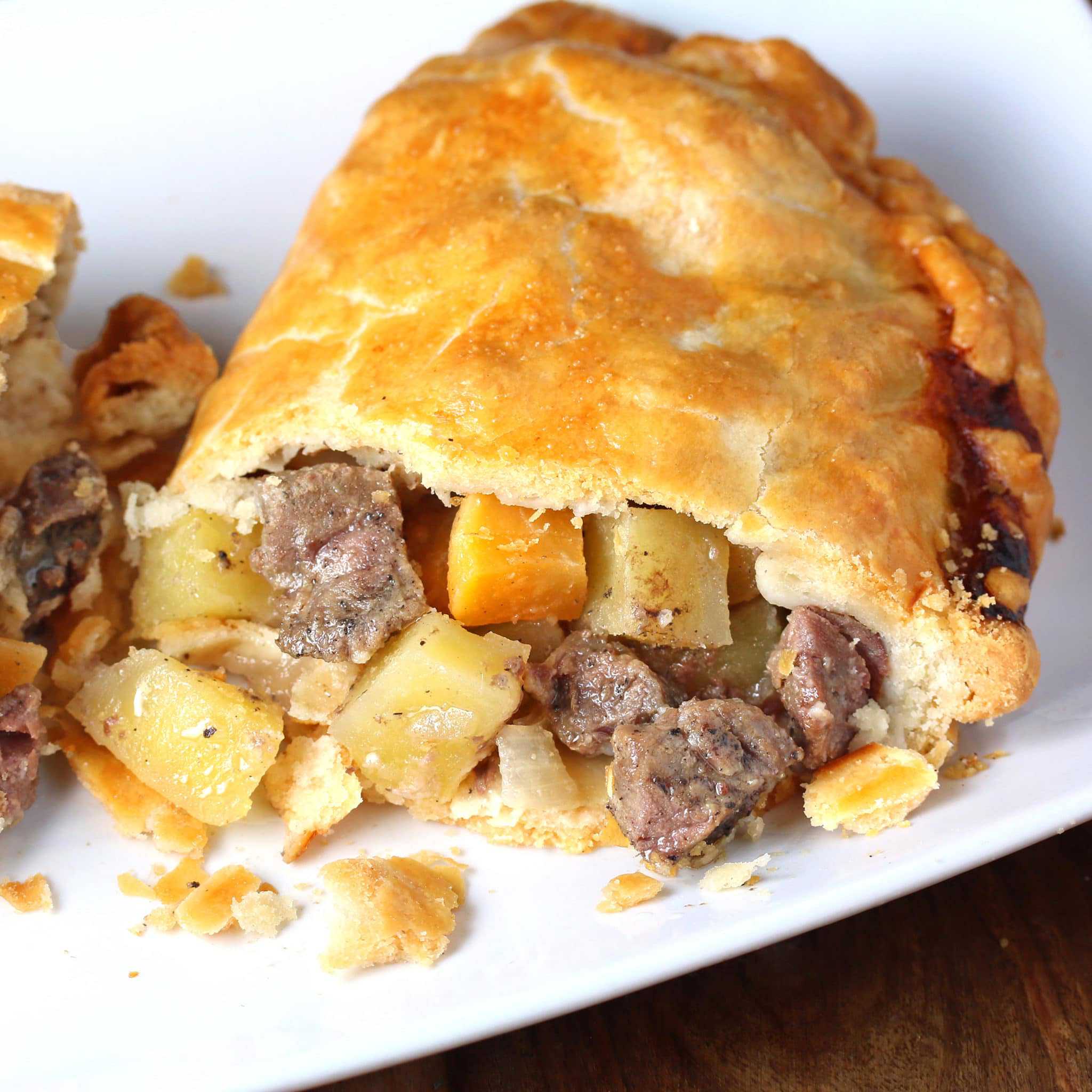
What is a Cornish Pasty?
A Cornish pasty is a turnover-shaped baked shortcrust pastry filled with beef and vegetables. The edges are sealed by crimping them in characteristic Cornish fashion.
In 2011, Cornish pasties were given both a Protected Designation of Origin (PDO) and Protected Geographical Indication (PGI) status, which means that in order for these pasties to be made commercially and bear the name “Cornish pasty”, they have to meet very specific requirements. These requirements are as follows:
- They have to be made in Cornwall.
- They can only contain beef, potato, Swede (rutabaga), onion, salt and pepper. No other meat, no other vegetables, no other seasonings allowed.
- The ingredients must be raw when the pasties are assembled and then slowly baked to produce the traditional Cornish pasty flavor and texture.
- The edges of the pasties must be sealed by crimping them in traditional Cornish fashion.
No culinary license allowed here and any deviations from these parameters will land you in stocks at the market square for public shaming. Well, that may be a stretch. But you will incur a fine.
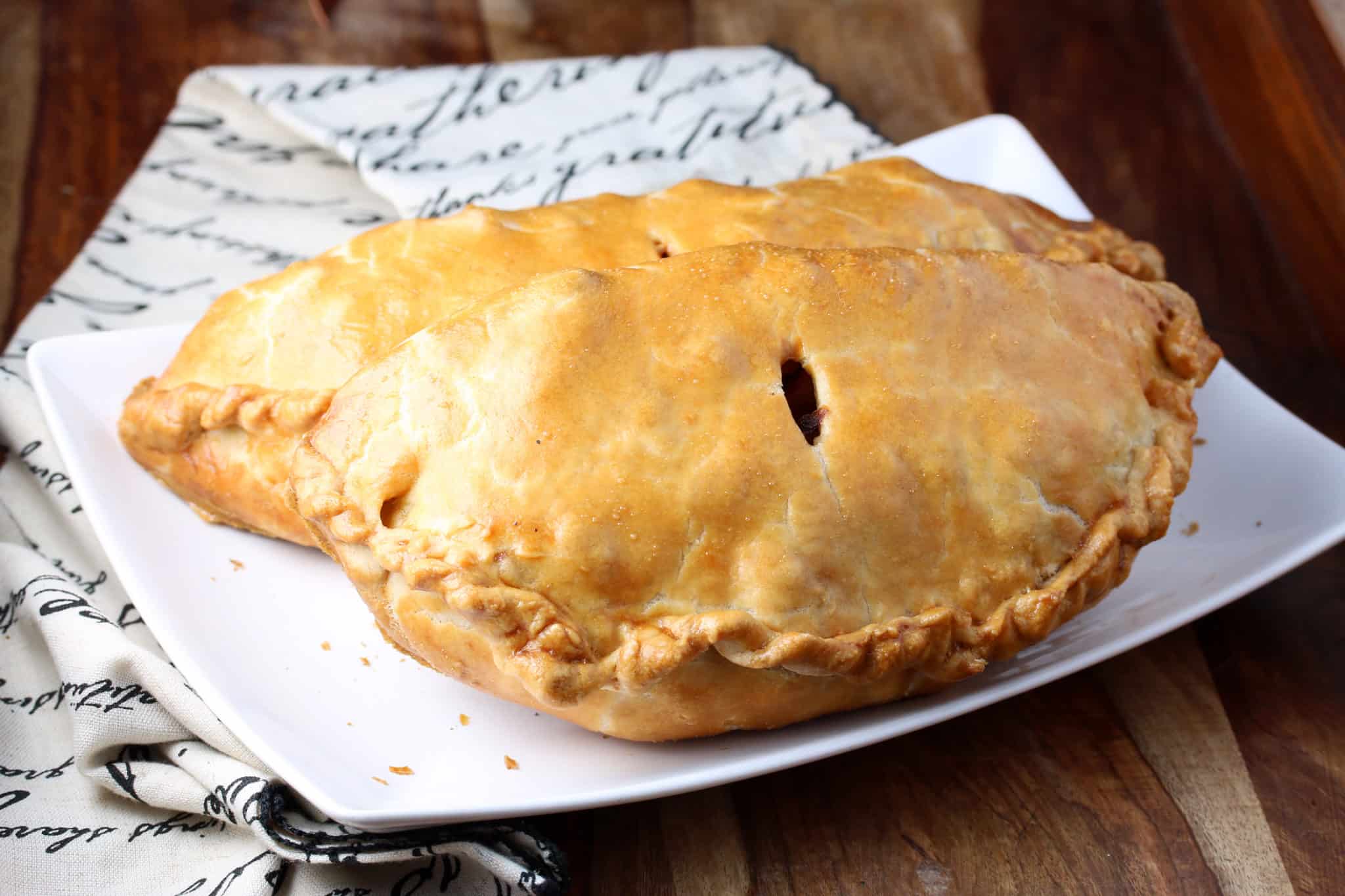
The Origin of the Cornish Pasty
The Cornish pasty has a unique and interesting history that goes back centuries. Cornwall had the biggest tin mining and one of the biggest copper mining industries in the world and the pasties were originally developed for Cornish miners. These men worked deep underground and needed a lunch that would meet the demands of their work environment. The thick shortcrust dough and dense filling would stay warm for several hours until lunchtime or could be easily reheated over the flame of an oil lamp.
The pasties were sealed with a thick crimp to hold in the contents and to provide something the miner’s could hold onto while eating the pasty. In this way their dirtied fingers, which could often contain traces of arsenic, wouldn’t contaminate the rest of the pasty. The crimped edge was sometimes extended out to form a little dough handle they could hold onto and then discard when they were done eating.
The filling was a hearty one that provided needed sustenance and the pasty was compact enough that it could easily be carried in a small lunchbox down the mine and eaten without utensils. Some historians also believe that the miner’s initials would sometimes be engraved in the dough at one end of the pasty so that if the miner didn’t finish it in one sitting they could easily identify it as their own.
Thoughtful wives would even take their ingenuity a step further and make pasties that were divided in two sections: One half would contain the savory filling and the other half a sweet filling for dessert. In this way the ingenious Cornish pasty was a complete meal for Cornwall’s hard-working miners.
A Few Pictures of Cornwall’s Historic Mines




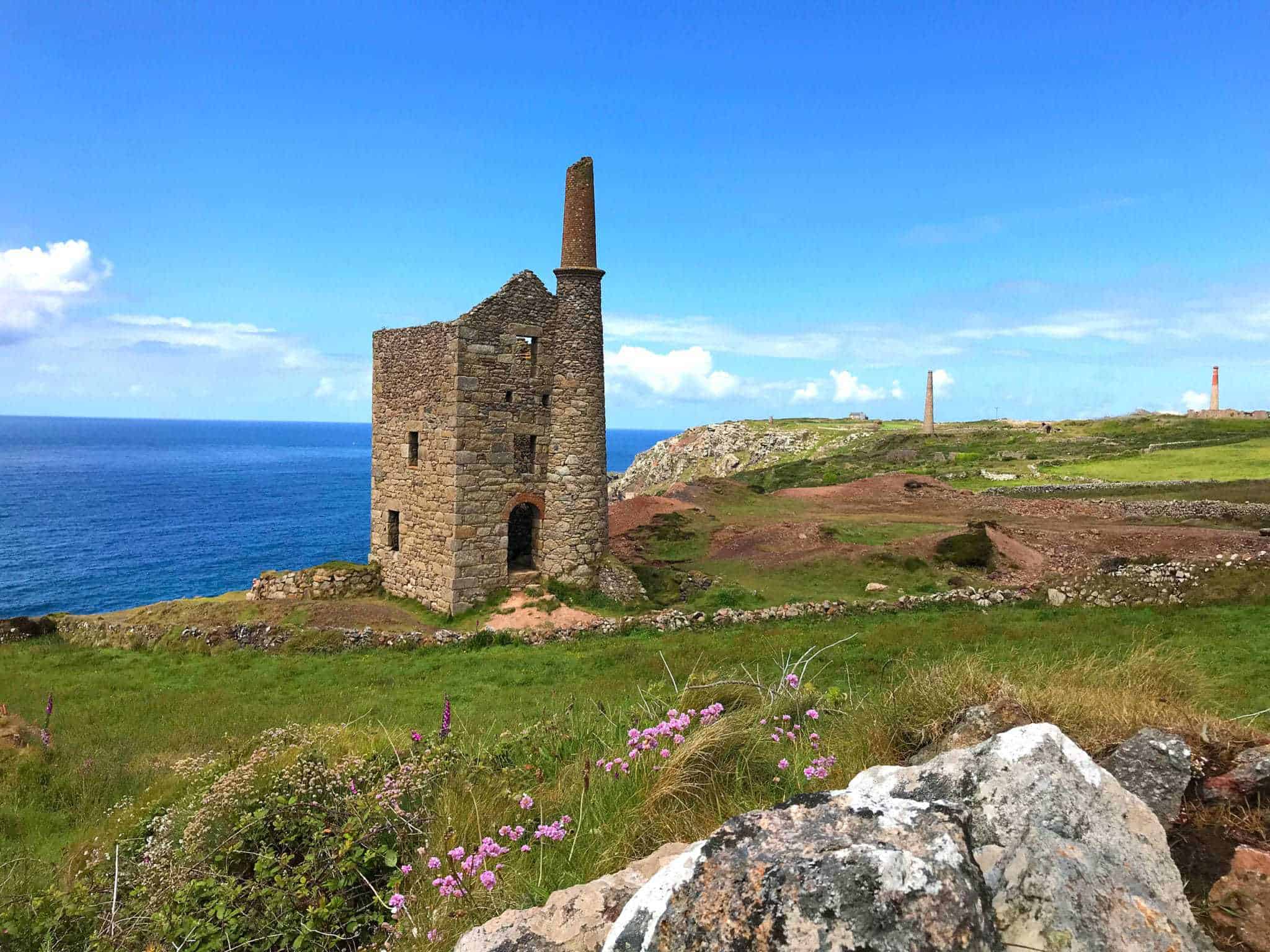



Tips for Making the Best Cornish Pasties
- A good, flaky shortcrust pastry is imperative, and I’m sharing my shortcrust recipe with you below that will ensure excellent results.
- Depending on how thin you roll out your shortcrust pastry you risk having the “hard” ingredients (the potatoes and rutabagas) pierce through the dough. If you prefer a thinner crust and you want to avoid that you can place the softer ingredients on the top and bottom with the harder ingredients sandwiched in the middle: Place the onions on the bottom followed by the potatoes and rutabagas and then the meat on top.
- Use firm, waxy potatoes so they hold their shape. Starchy potatoes will disintegrate during baking and turn mushy.
- Use a lean cut of beef. Traditional Cornish pasties use skirt steak from the underside belly of the cow because it’s lean and free of gristle.
- Add a couple of pats of butter on top of the filling ingredients followed by a light sprinkling of flour. This will both form the gravy as well as absorb the liquids from the vegetables as their cooking to avoid a soggy pastry crust.
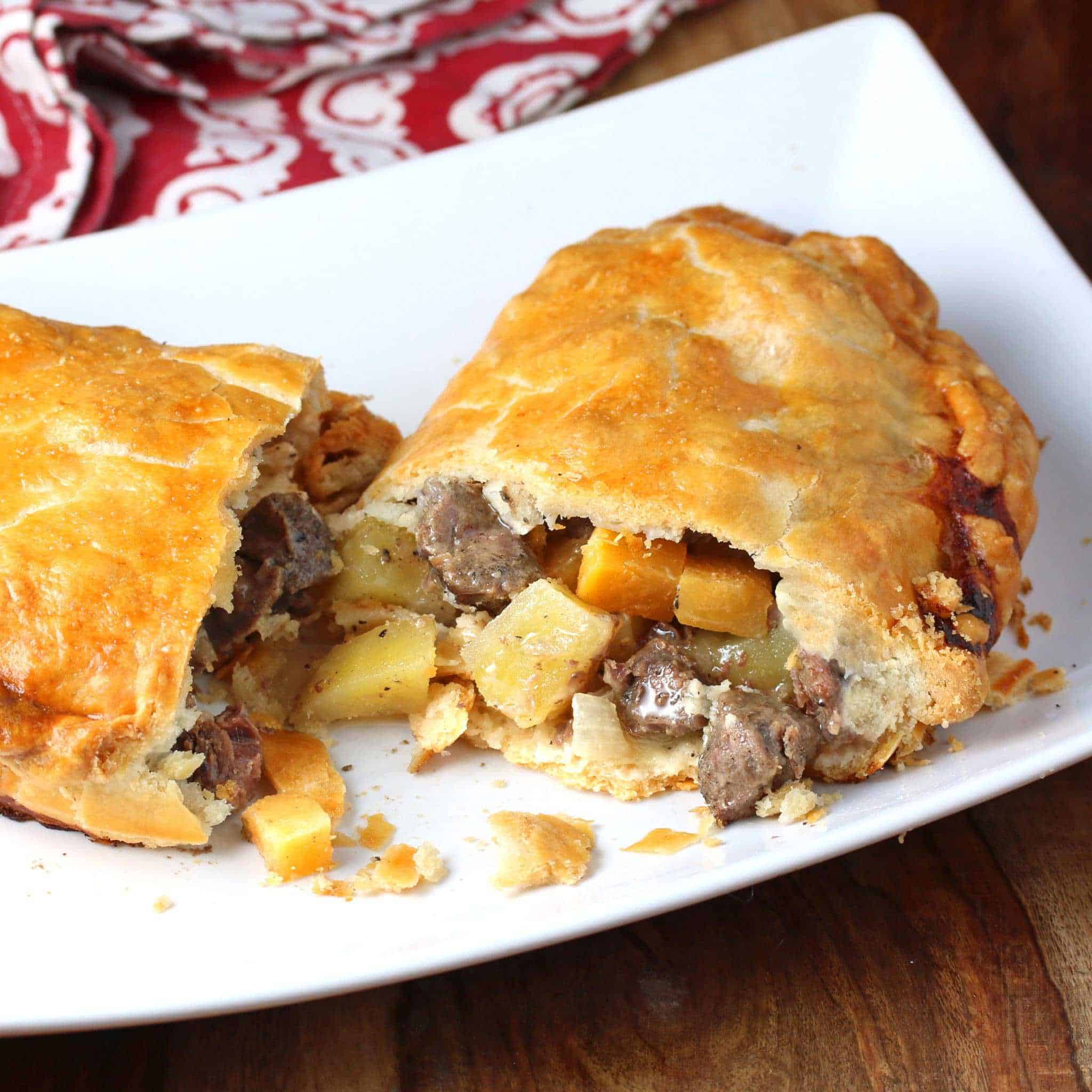
Cornish Pasty Recipe
Let’s get started!
First make your shortcrust pastry:
Place the flour and salt in a food processor and pulse a few times until combined. Add the cold butter and lard and pulse a few more times until the mixture resembles coarse crumbs.
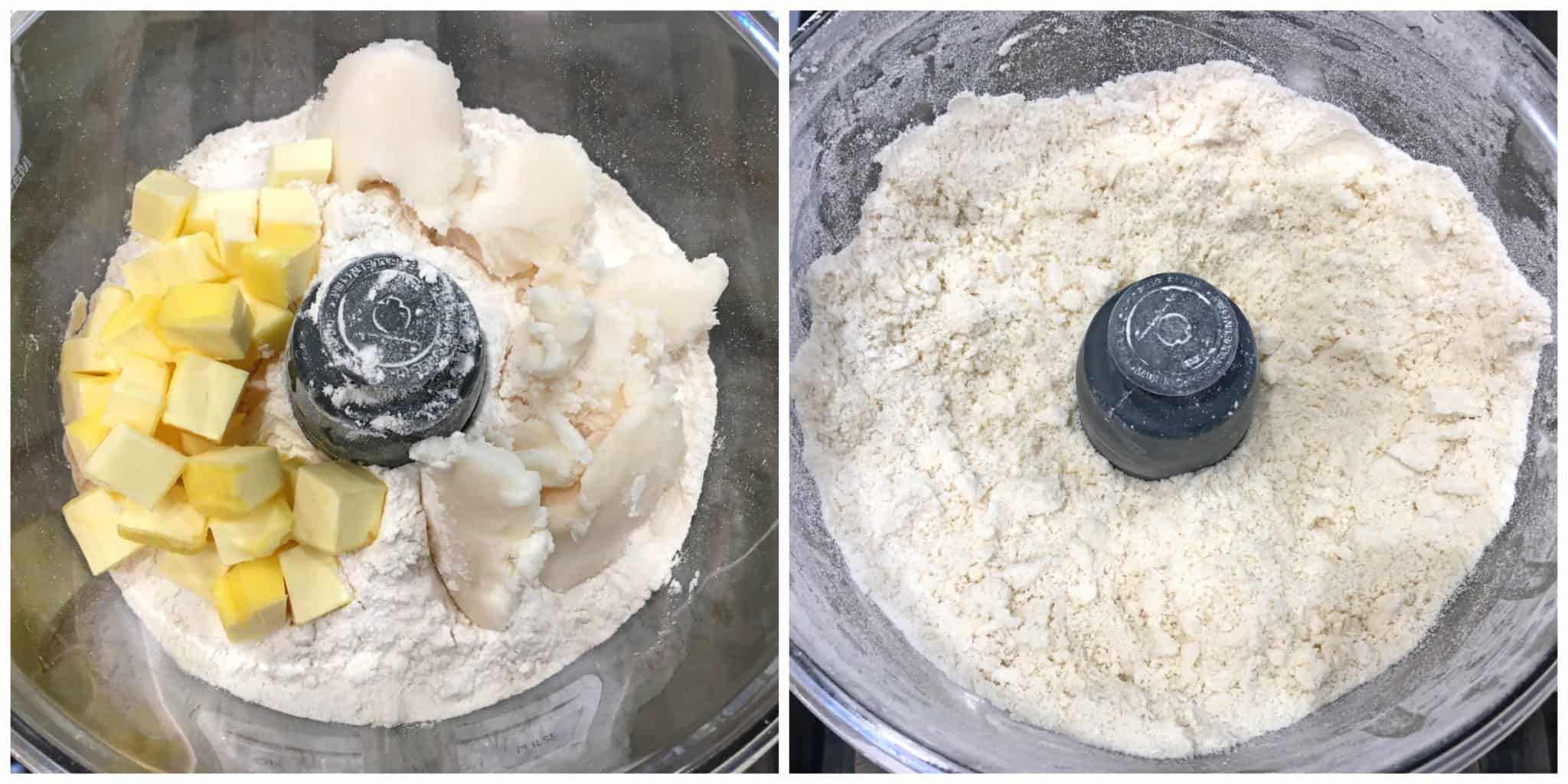
Add the water a little at a time, pulsing between additions, until the mixture begins to come together. DO NOT over-mix the dough or the pastry crust will be tough and won’t be flaky.
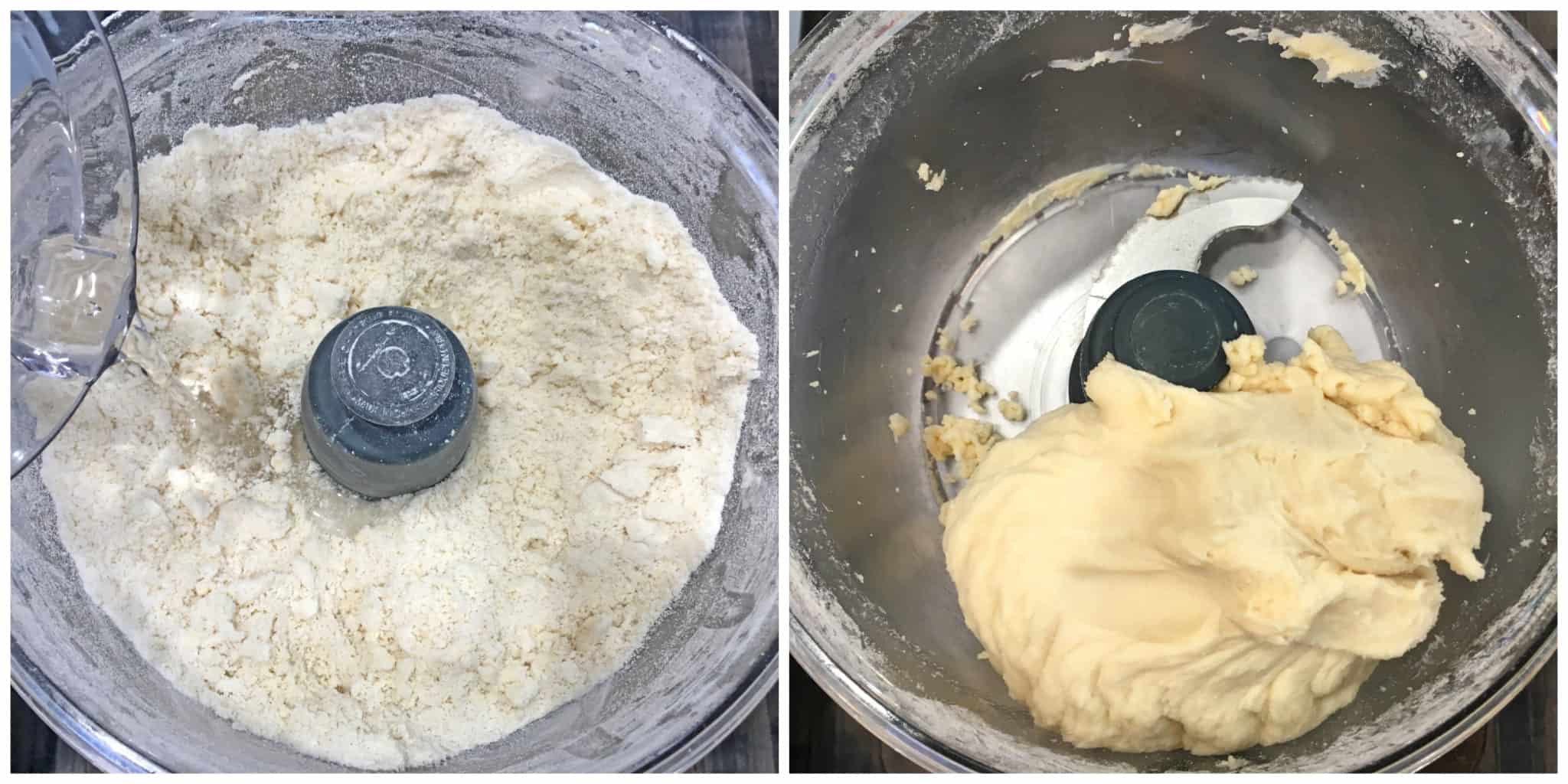
Form the dough into a ball, flatten into a 1-inch thick disk, wrap in plastic wrap and refrigerate for at least 3 hours before using (this is crucial). (Can be refrigerated for a few days or frozen for up to 3 months.)
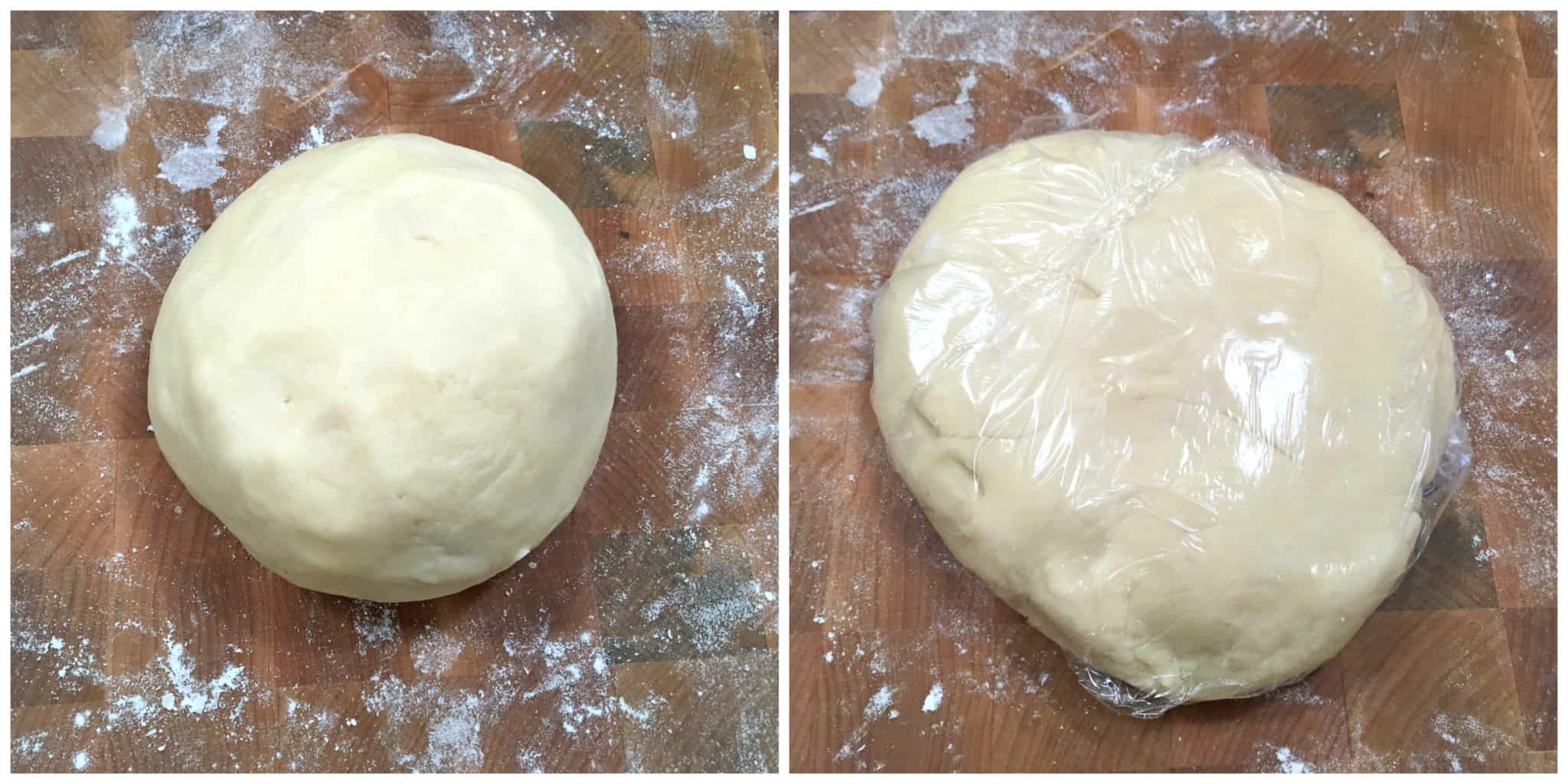
Roll the pastry dough into a log and cut it into 6 equal pieces.
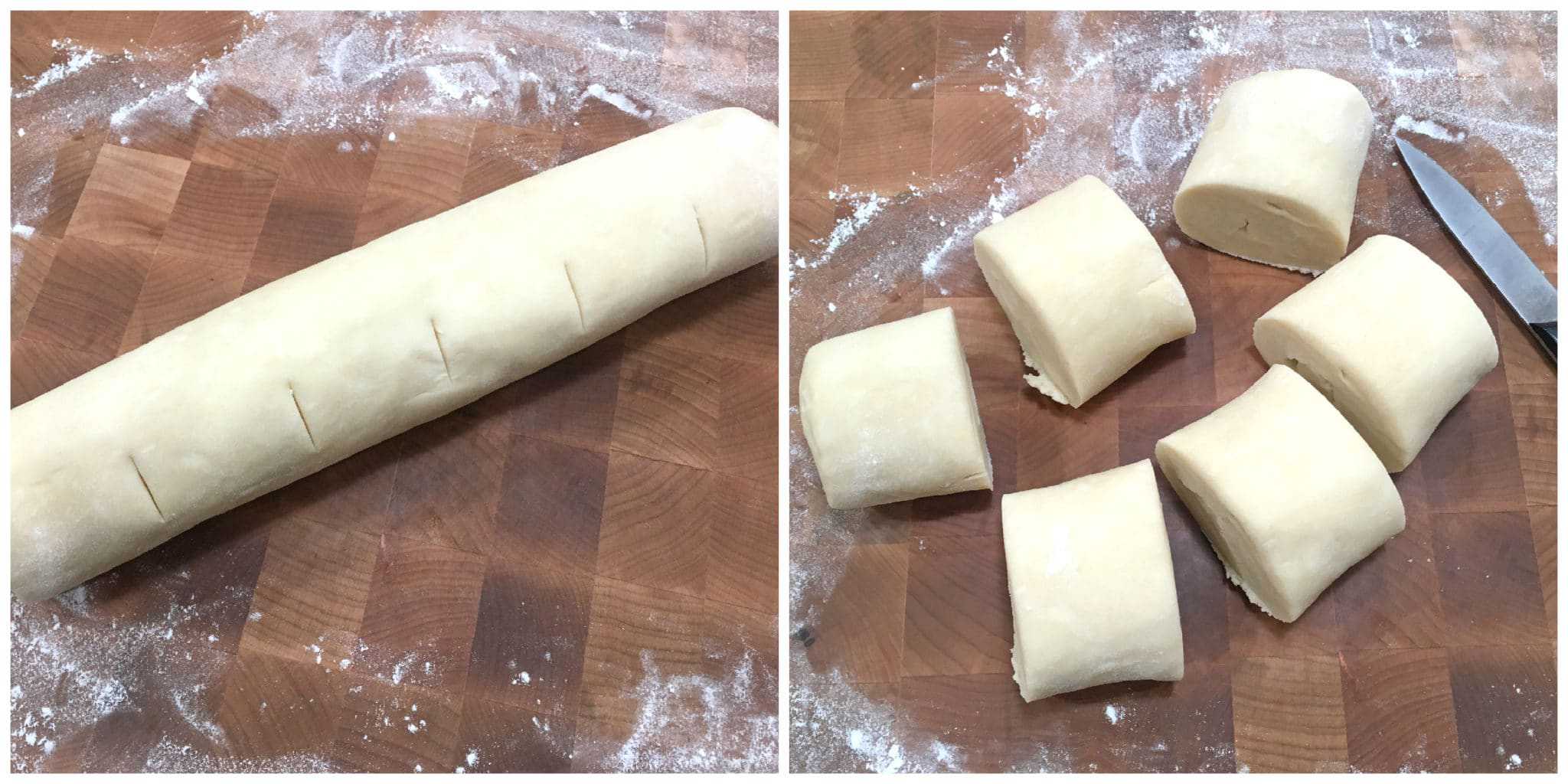
Wrap and keep the other 5 pieces chilled in the fridge while you’re working on one at a time. Roll the dough out on a lightly floured work surface to a 8 inch circle that’s about 1/8 inch thick. You can use an 8-inch plate as your guide and cut the dough around it to form your circle.
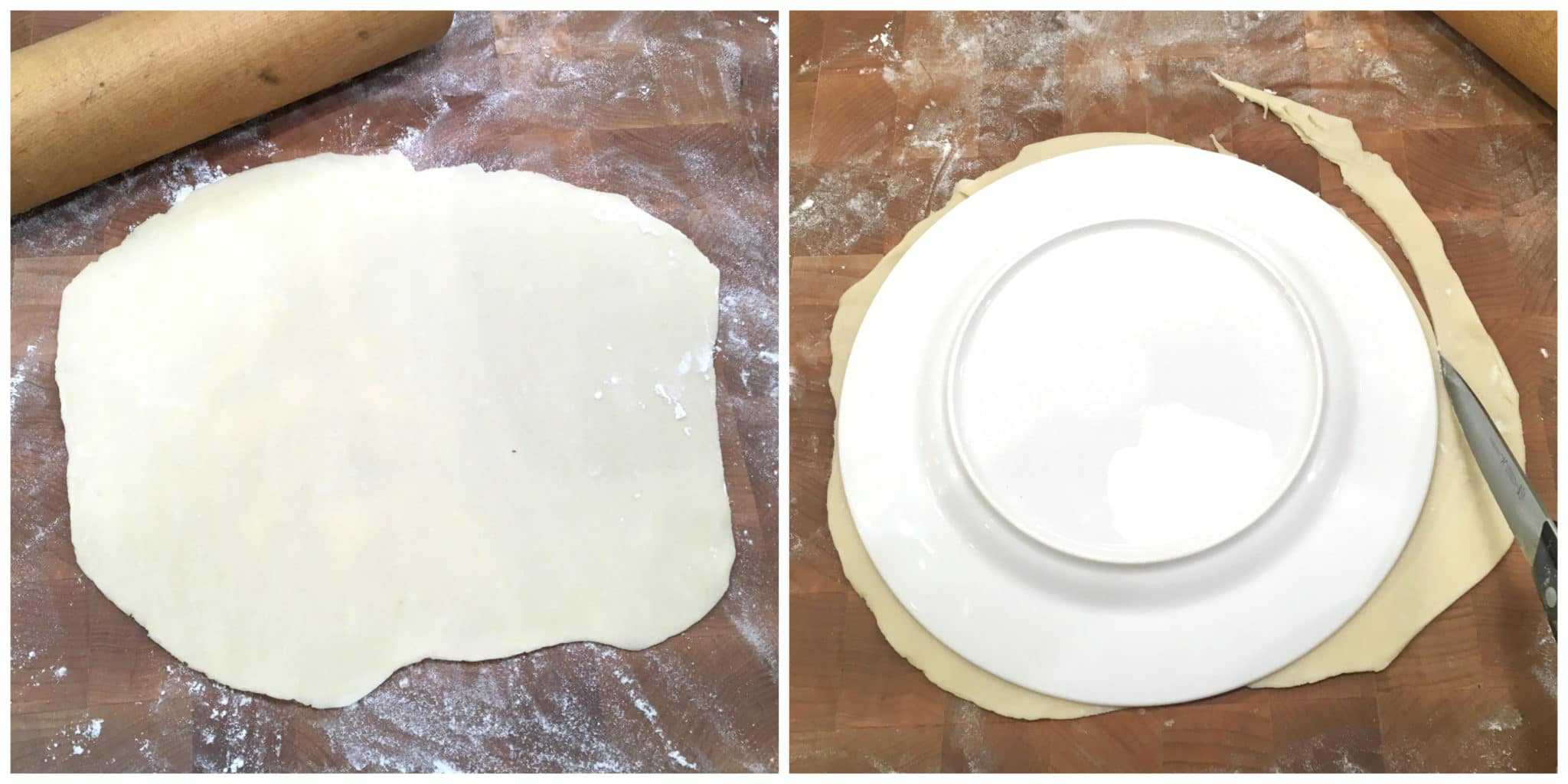
Layer the filling (each ingredient to be divided out between 6 pasties, there may be some excess remaining): Put layer of potatoes down the center of the pastry circle, leaving about 3/4 inch space on the top and bottom edges of the pastry dough. Lightly sprinkle with salt and pepper.
Next add a layer of rutabagas and sprinkle with salt and pepper.
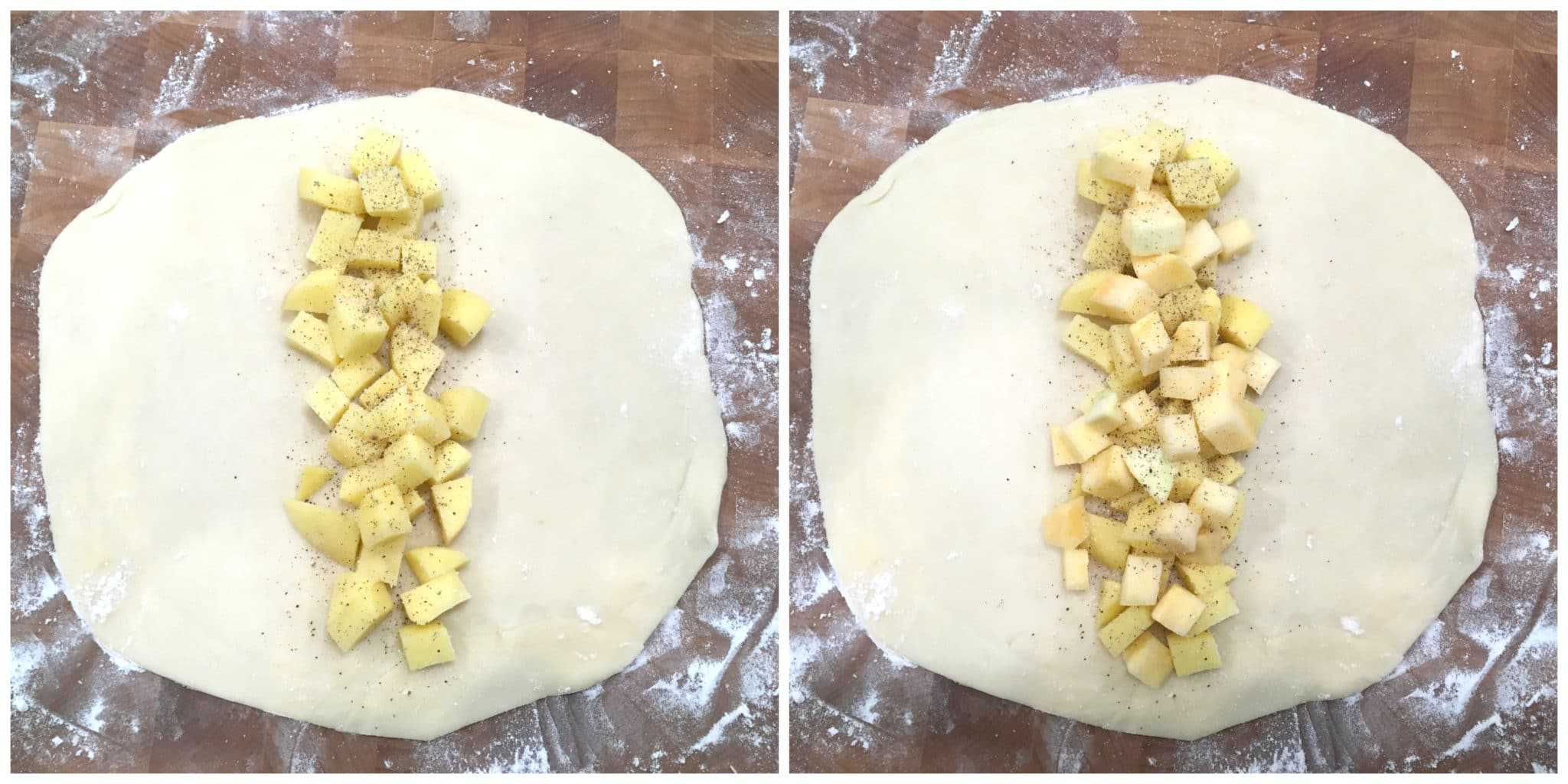
Add a layer of beef followed by the onions and sprinkle with salt and pepper.
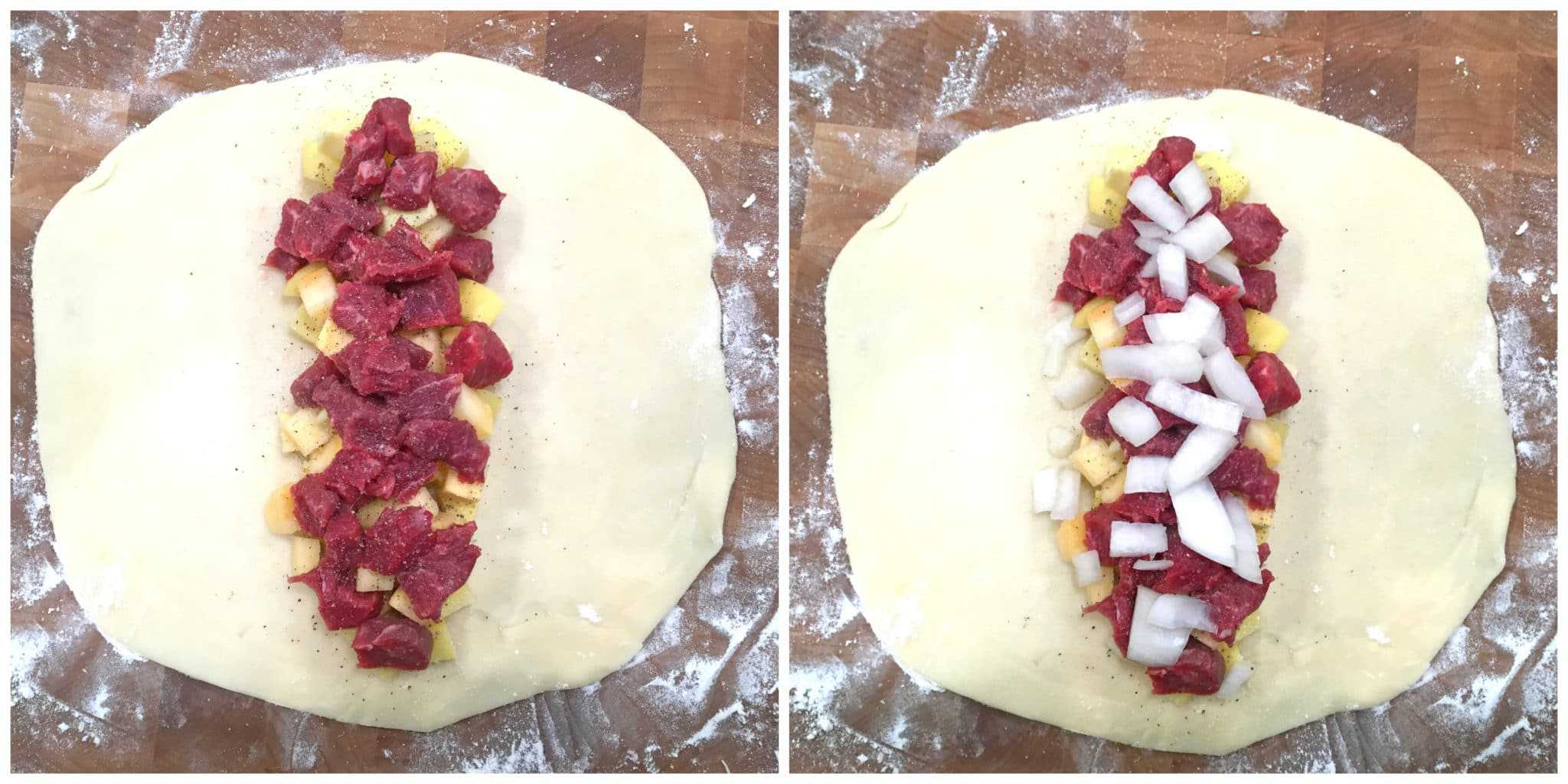
Lay a couple of pats of butter on top of the beef and sprinkle a little flour over the filling.
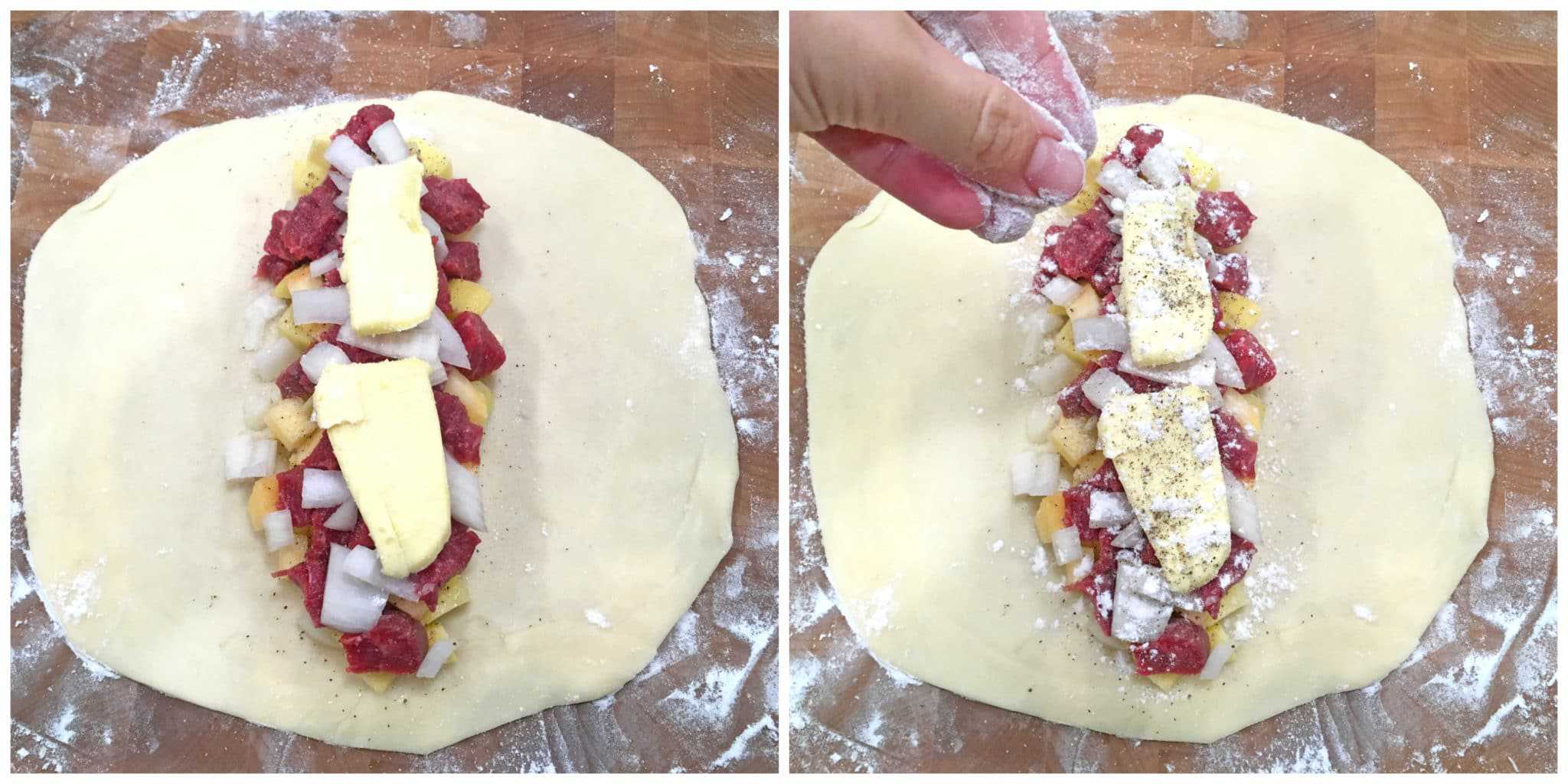
Wet the tips of your fingers and lightly moisten the edges of the pastry dough.
For the remaining steps work gently so that the filling doesn’t puncture through the dough. If this happens, patch up the hole with some of the scrap pieces of pastry dough. Bring the sides up and seal the pasty down the middle.
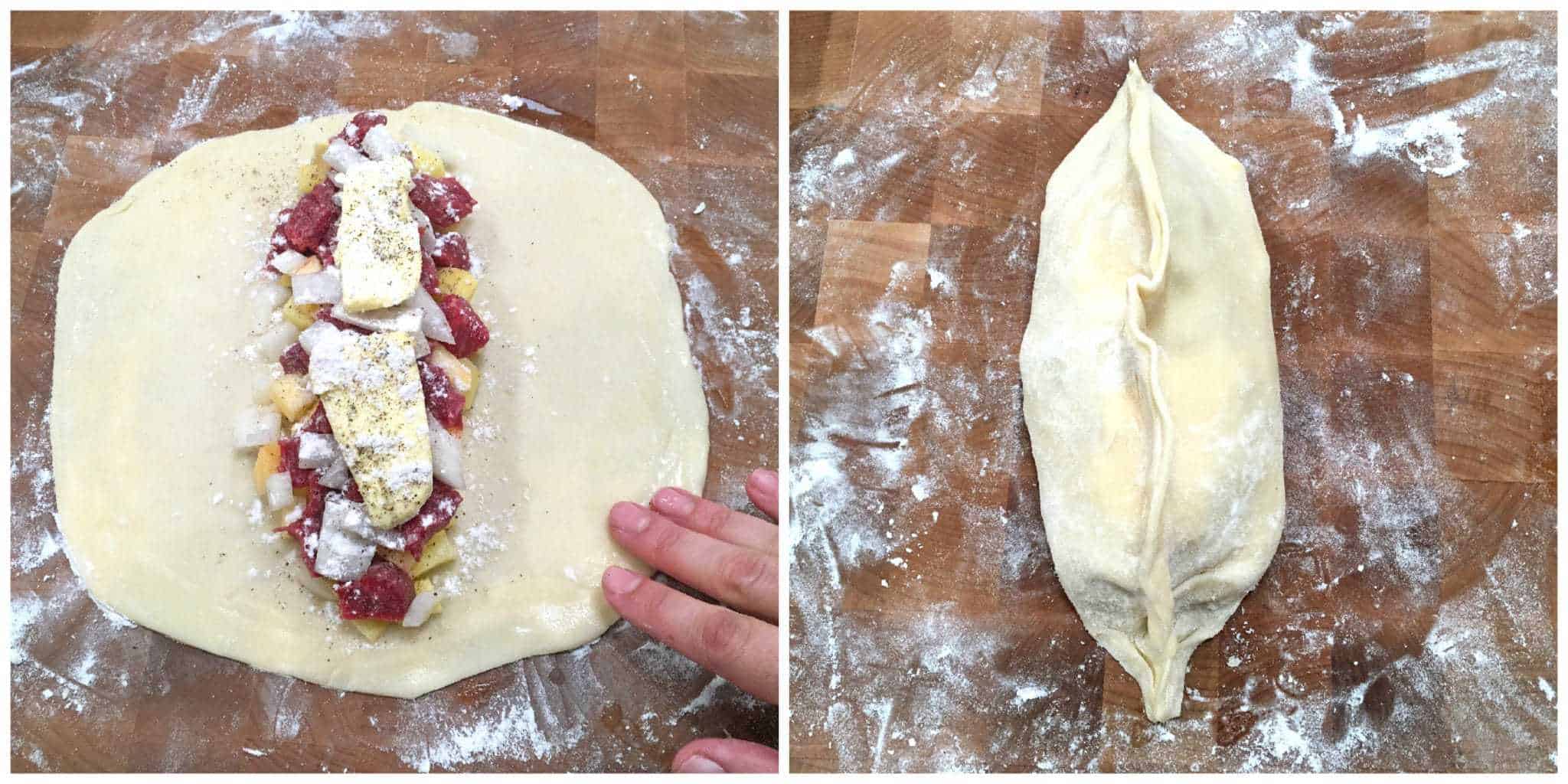
Turn the pasty onto its side and crimp/braid the edges in traditional Cornish fashion. This is the challenging part of making traditional Cornish pasties and takes some practice. There are some YouTube videos you can look up that show how to do this.
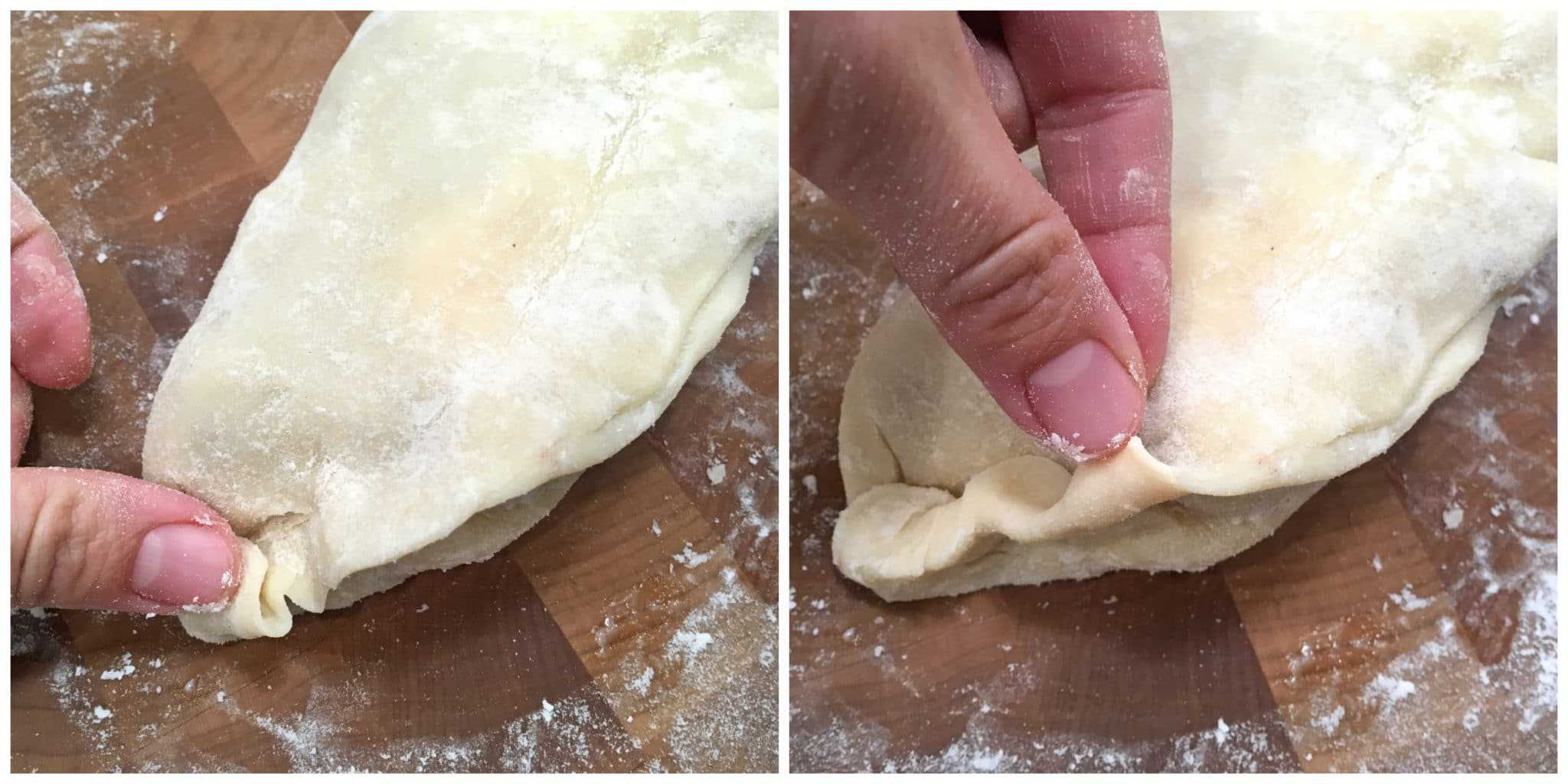
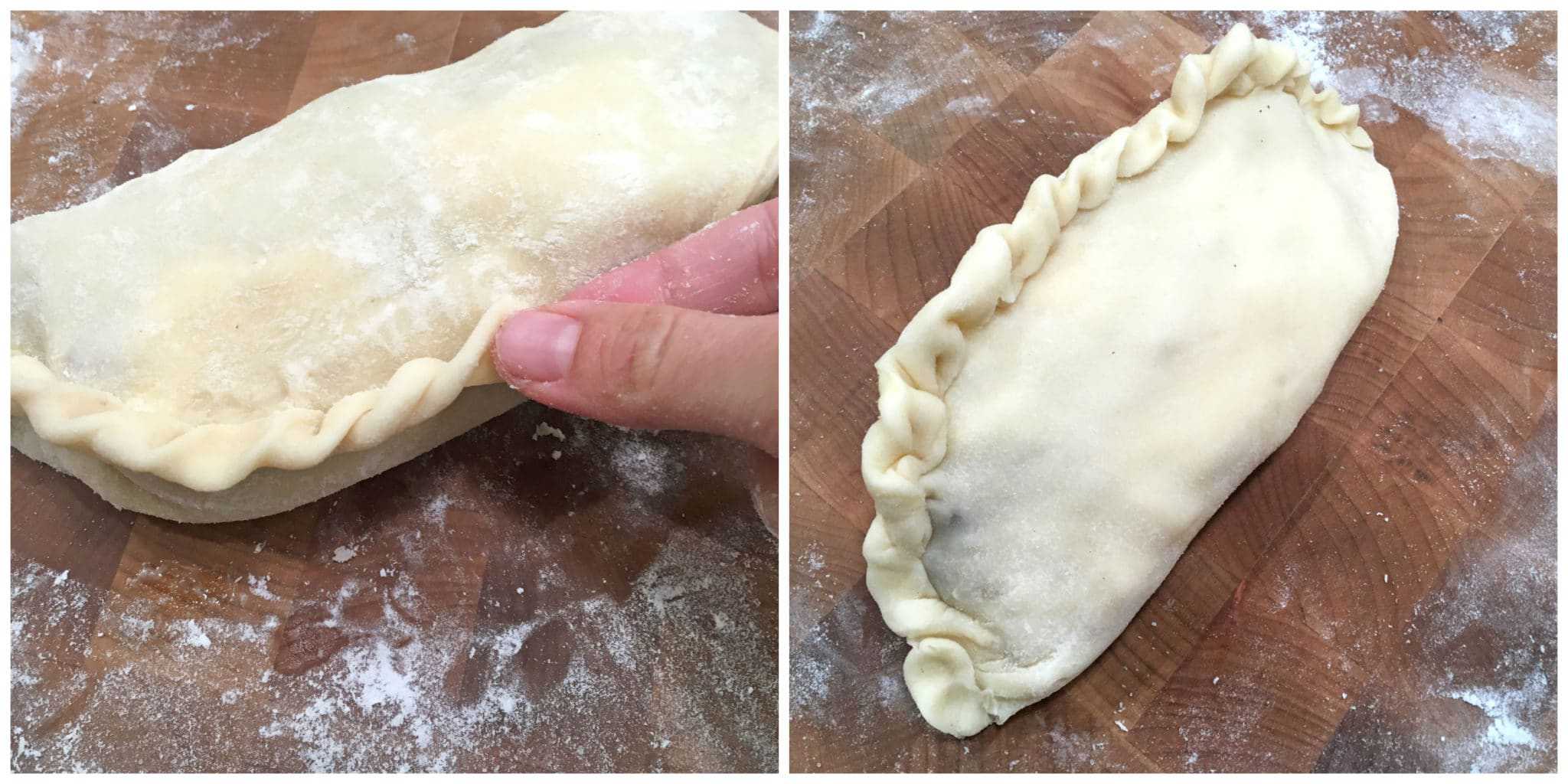
Assemble the remaining pasties and lay them on a lined baking sheet.
Use a sharp knife to cut a slit in the center of each pasty.
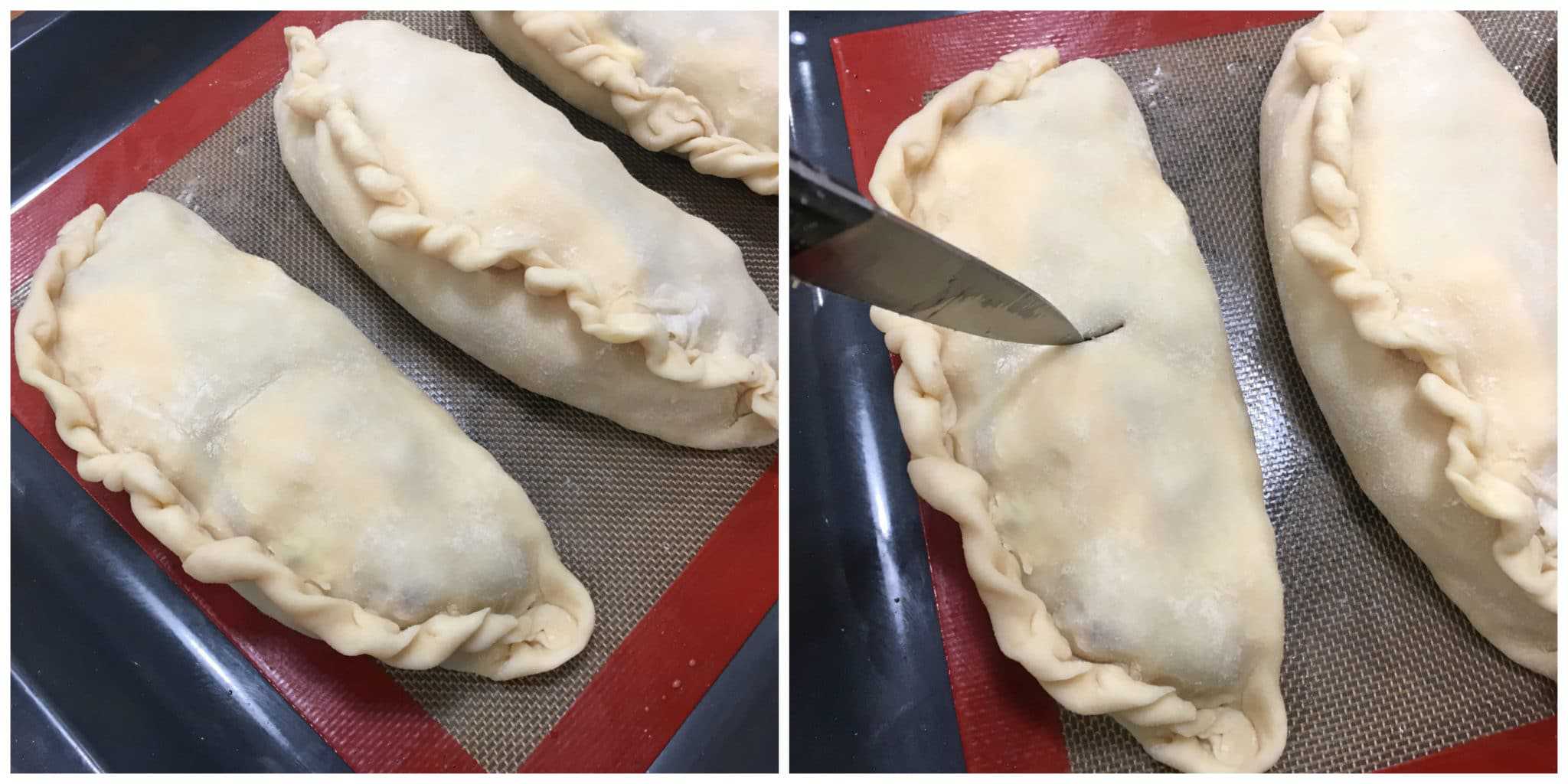
Lightly brush each pasty with the beaten egg mixture.
Bake the Cornish pasties on the middle rack for 40-50 minutes until golden in color. Remove from the oven and let them sit for about 10 minutes (they will be very hot inside) before eating.
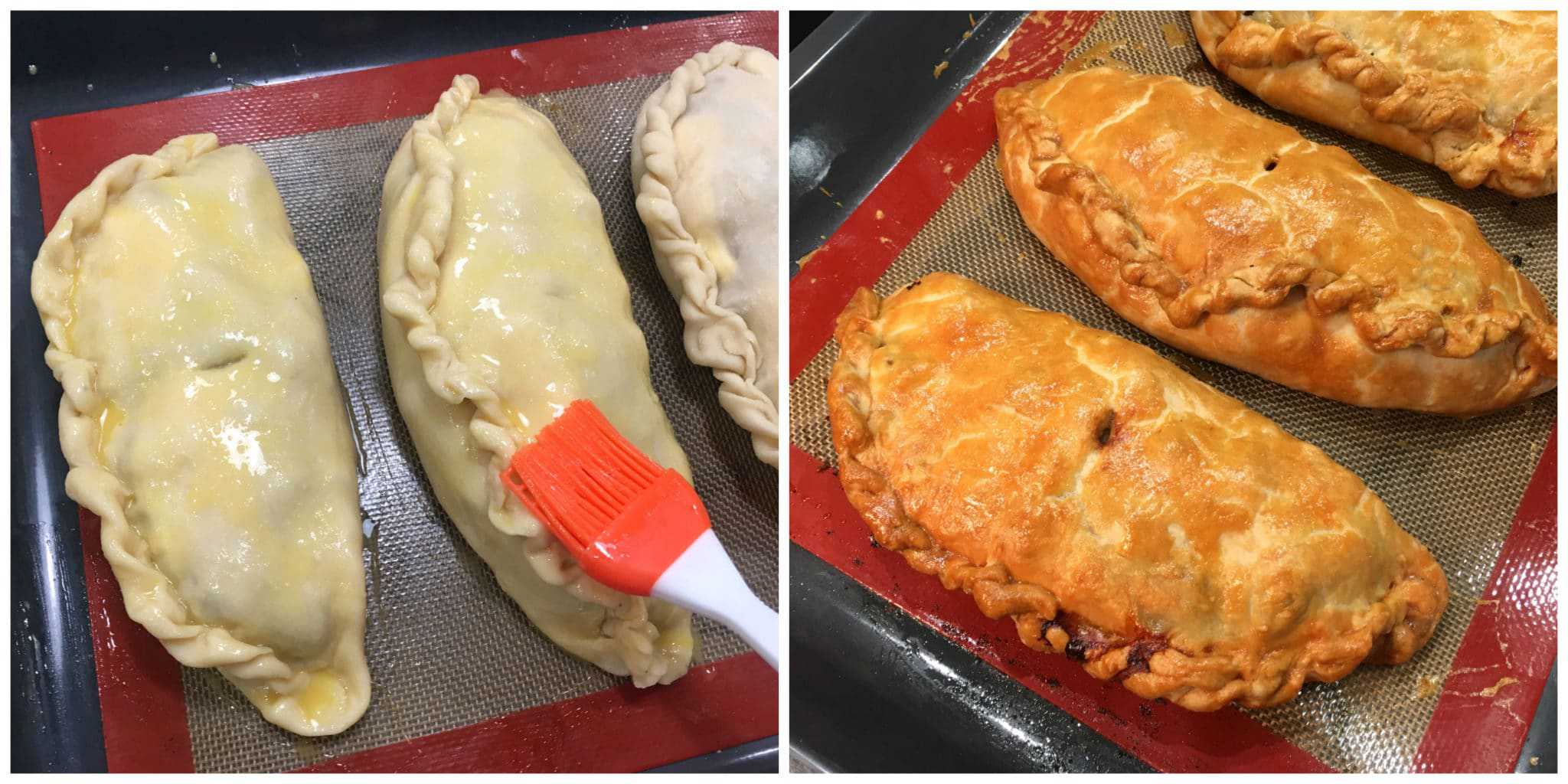
The homemade Cornish pasties can be reheated in the oven or in microwave, but for a crispy crust I highly recommend reheating them in the oven.

Can Cornish Pasties Be Frozen?
Yes. The shortcrust pastry holds up well to freezing and thawing and the filling has little liquid which means the pasties won’t get soggy. You can freeze them either baked or unbaked, whichever you prefer. Wrap each pasty individually in plastic wrap and then store the wrapped pasties in a heavy-duty freezer bag.
If you’re freezing them unbaked it’s best to cook them while frozen – don’t thaw them first. Baking time will take roughly 15-20 minutes longer.
If you’re freezing them already fully baked and cooled then you can simply reheat them in the oven (for a crispier crust) or in the microwave and you have a quick, ready-to-go meal.
Enjoy!
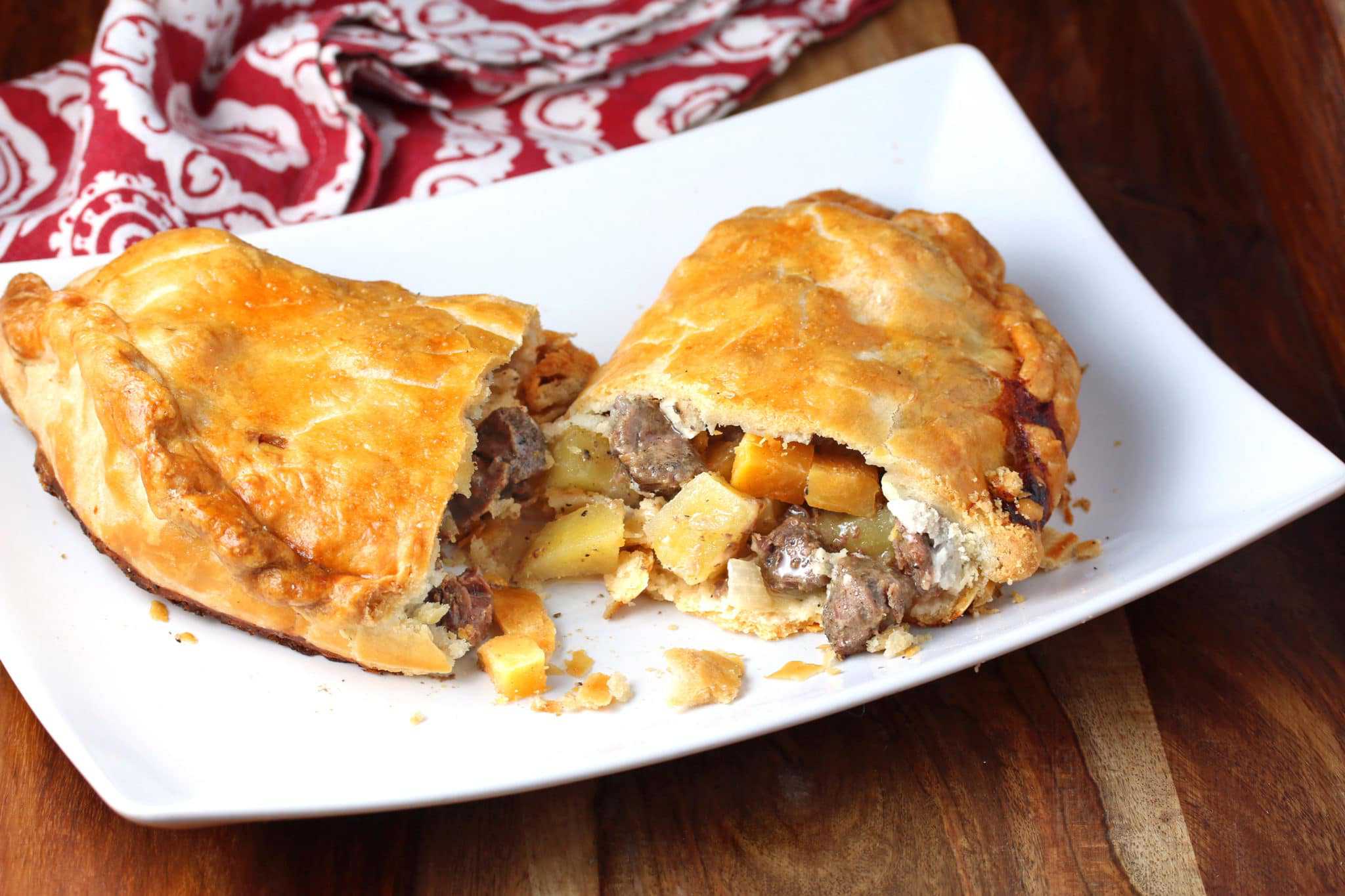
For more favorite British recipes try my:
- Fish and Chips
- Yorkshire Pudding
- Mushy Peas
- Bangers and Mash
- Scotch Eggs
- Crumpets
- Cornish Fairings
- Sticky Toffee Pudding
- Mincemeat Pie
- Beef and Guinness Stew
- Spotted Dick
- Chelsea Buns
- Toad in the Hole
- Eccles Cakes
- Scottish hortbread
- Treacle Tart
Save This Recipe
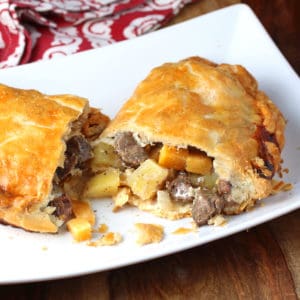
Authentic Cornish Pasty Recipe
Ingredients
For the Shortcrust Pastry:
- 3 1/2 cups all-purpose flour or bread flour (I make mine with all-purpose flour)
- 1 teaspoon salt
- 5 ounces unsalted butter , very cold, diced
- 5 ounces lard , very cold (can substitute butter but lard makes the flakiest crust)
- How to Render Lard (click link to learn how to make it yourself. It's super easy and much cheaper than store-bought!)
- 2/3 cup ice cold water
For the Cornish Pasties:
- 1 pound beef skirt steak or sirloin , cut into small cubes
- 1 pound firm, waxy potato (e.g. Yukon Gold) , peeled and diced in 1/4 inch cubes, or slice them according to personal preference (**starchy potatoes will disintegrate and turn mushy so be sure to use a firm, waxy potato that will hold its shape)
- 8 ounces rutabaga , peeled and diced in 1/4 inch cubes, or slice them according to personal preference
- 7 ounces yellow onion , chopped
- salt and pepper to taste
- unsalted butter (for cutting in slices to lay inside the pasties)
- all-purpose flour (for sprinkling inside the pasties)
- 1 large egg , lightly beaten
Instructions
- To Make the Shortcrust Pastry: Place the flour and salt in a food processor and pulse a few times until combined. Add the cold butter and lard and pulse a few more times until the mixture resembles coarse crumbs. Add the water a little at a time, pulsing between additions, until the mixture begins to come together. DO NOT over-mix the dough or the pastry crust will be tough and won't be flaky. Form the dough into a ball, wrap in plastic wrap, and refrigerate for at least 3 hours before using (this is crucial). (Can be refrigerated for a few days or frozen for up to 3 months.)
- To Make the Cornish Pasties: Preheat the oven to 350 degrees F.Cut it into 6 equal pieces (rolling the dough into a log and then cutting makes this easier). Wrap and keep the other 5 pieces chilled in the fridge while you're working on one at a time. Roll the dough out on a lightly floured work surface to a 8 inch circle that's about 1/8 inch thick. You can use an 8-inch plate as your guide and cut the dough around it to form your circle.
- Layer the filling (see note at end): Put layer of potatoes down the center of the pastry circle, leaving about 3/4 inch space on the top and bottom edges of the pastry dough. Lightly sprinkle with salt and pepper. Next add a layer of rutabagas, onions and finally the beef, adding a light sprinkling of salt and pepper between each layer. Lay a couple pats of butter on top of the beef and sprinkle a little flour over the filling.
- Wet the tips of your fingers and lightly moisten the edges of the pastry dough. For this next part work gently so that the filling doesn't puncture through the dough. If this happens, patch up the hole with some of the scrap pieces of pastry dough. Bring the sides up and seal the pasty down the middle. Turn the pasty onto its side and crimp the edges in traditional Cornish fashion (see blog post pictures as a visual).
- Assemble the remaining pasties and lay them on a lined baking sheet. Use a sharp knife to cut a slit in the center of each pasty. Lightly brush each pasty with the beaten egg mixture.
- Bake the Cornish pasties on the middle rack for 40-50 minutes until golden in color. Remove from the oven and let them sit for about 10 minutes (they will be very hot inside) before eating. They can be reheated in the oven (recommended for a crispier crust) or microwave. NOTE: Depending on how full you stuff the pasties you may have leftover filling. No worries, just fry it up together or add it to soup and enjoy it as a separate meal.
Nutrition
Originally published on The Daring Gourmet January 22, 2020



















So, so good and I used bacon grease which had been through a sieve instead of lard.
Oh these were so good! I’m afraid I substituted carrots for the rutabagas as some of us can’t abide rutabagas (sorry to all of you from Cornwall) but even so, they were fantastic. I will definitely be making these again.
I grew up in Cornwall so I know a good pasty when I taste one. This recipe delivers, oh my goodness! I was so happy to taste exactly what I was hoping for, ok my crimping leaves a lot to be desired but who cares when you have that authentic, unique flavour that is a Cornish Pasty?
Thank you for this recipe. It’s a keeper.
Thank you so much, Vicky, I really appreciate the feedback! :)
This recipe is amazing! Although confession I made a few changes, I didn’t have lard so just used all butter instead, best pastry for pasties ever. I used carrot and pork mince instead, again as this was all I had to hand as I made these on a spur of the moment for a picnic at the seaside the next day. The pasties were really enjoyed by the whole family with requests to make them more often, they completed a wonderful sunny day by the sea! Thank you for sharing this recipe
I’m so glad you enjoyed it, Ann, thank you very much!
These are amazing! I’ve made them a couple of times (and making them again today for my brother) and they taste just like the one I had in Wales. Thank you for this recipe!
Wonderful, Lindsay, thank you so much!
I also use to live in Cambridgeshire (St. Neots). When the family and I traveled to London on the train, I would always grab a pasty at the West Cornwall Pasty Co. at Kings Cross. Delicious. I haven’t had one since about 2008 until I made this recipe – you nailed it! This recipe is fantastic and totally on point! Thank you for posting.
I know St. Neots well, Rob. I’m so glad you made and enjoyed these pasties and really appreciate the feedback, thank you!
I am nearly 10 years old and I love absolutely love baking and pottering in my Mum’s kitchen. I found this recipe on the website and decided to try making the pasties. The instructions were clear and easy to follow. I did everything by myself and my family were so so happy with the pasties I made. They want me to make these again. Thank you so much. xoxo
You are incredible, Reiss! Congratulations on the success of your pasties and wishing you the best in your ongoing cooking adventures!
Hi Kimberly,
You are a GENIOUS! These were absolutely fantastic. I followed the recipe as is and they turned out authentic and truly tasty! Now I can’t wait to try all the other recipes on your site.
Thank you!
Thank you so much for your generous compliment, Jane, I’m so glad you enjoyed these and hope you enjoy any other recipe you try here!
It’s my understanding that in Cornwall sealing the pasty traditionally was/is done using a roping technique rather than a crimping one. Of course this difference doesn’t affect the taste. I have read that miners carried their warm pasty wrapped and stored inside their shirts to keep themselves warm until it’s time for lunch. Apparently Finnish miners in the U.P. adapted the Cornish pastry by substituting carrot for rutabaga.
A appreciate the clear instructions for assembling these culinary gems.
I’ve been looking for a Pasty recipe that would take me back to when I was a kid, traveling the U.P. of Michigan with my grandparents. We would hit Pasty stands all over the U.P. and I loved them. I have tried several other recipes and they just didn’t hit the mark. The ones with ground beef were mushy & bad, some crusts were more like dry hard pizza crust than a good, flaky but strong pastry crust. This one, however, was GREAT! The flavor, texture, and meat-veggie ratio was what I remembered from my favorite Pasties. The crust, however is what really makes this recipe shine! It was perfect! It is easy to make, flaky, AND strong enough to hold plenty of filling. I was also able to eat them without a fork!
I made some minor alterations, one of which would get me put in stocks in Cornwall. I made a double batch and used salted butter rather than unsalted (no biggie here). As for the meat, I couldn’t find skirt steak, so I used flank instead. I cut it into 1/4″ cubes and it worked great (again, no biggie). My crime (in Cornwall) was replacing a 8oz of the potato for small diced carrot for a slightly more assertive root veggie flavor.. Thanks for posting the recipe!
Thanks so much, Paul, I really appreciate the feedback and am so glad you enjoyed these! I love the crust too and use the same recipe for a variety of pastries. And don’t worry about your culinary crime, I won’t tell the Cornish food police ;)
These look amazing! We are making them for a dinner we are having with friends. Any recommendation on side dishes or appetizers to serve with these?
Hi Lisa, pasties are pretty much a complete meal and are generally eaten alone with nothing more than some chutney or piccalilli to accompany them. If you’re going to serve something with them I would make it something light like a simple salad (no additional heavy carbs like potatoes or fries).
Great recipe! I had never made a pastie before (or eaten one either) and these were delicious! Thank you!
The only thing I would like to mention is that the number of Servings heading and the Ingredients 1x, 2x, 3x don’t actually change the metric amounts. For example, when changing ingredients from 1x to 2x, the amount of butter changes from 5 ounces to 10 ounces, as it should. But, the weight in grams stays at 140 grams. It messed me up for a bit since I was measuring the water in mls. I figured it out though. I just wanted others to know.
Thank you again for a great recipe.
Thank you, Bon, I’m so happy you enjoyed them! I apologize for the frustration of not being able to increase the ingredients and have the measurements all populate correctly. It’s because I had to enter the metric measurements manually and so the conversion software won’t work for grams, those will have to be calculated manually if you’re increasing the batch. Again, I’m sorry for that extra step.
I made this recipe this evening and it was absolutely delicious. I am thinking of having a second pasty as I type this message! Though, to be sure, the size of each is a full meal in itself. This was the first recipe I found and it worked very well for me. It seems that I had more than enough filling though. I followed everything to the letter and weighed all ingredients on a digital scale to the nearest gram. Seems that an 8″ diameter crust was just barely enough to wrap up the filling. I will scale back the amount of filling by about 1/4 next time I try it (which will be soon!)
Thanks very much for sharing your recipe.
Thanks so much, David, I’m happy they were a success!
Enjoyed reading your site and seeing the photos of “The Crowns” at Botallack (one of my favourite places when visiting my birthplace… Penzance).
I’m carrying on the tradition of making Cornish pasties here in Crete, Greece… for myself and close friends only, of course!
Interesting that your Polish grandmother also made pasties 🥟.
Just an interesting addtion, I hope! My grandparents were Polish immigratns who settled in Michigan’s Upper Peninsula. My grandfather was an iron miner. I grew up eating pasties that my grandmother made and that he took to work in the mines. I was told pasties came over with the “Cousin Jacks” a slang for the Cornish. Miners took the pasties to work in a pail that had hot coffee on the bottom with a pastie sitting on top of a divider above to keep it hot. I didn’t realize how popular and beloved pasties were in Cornwall until I went there in 1999. I still make them from my grandmother’s recipe which is exactly like yours.
Very neat, Anne, thanks so much for sharing!